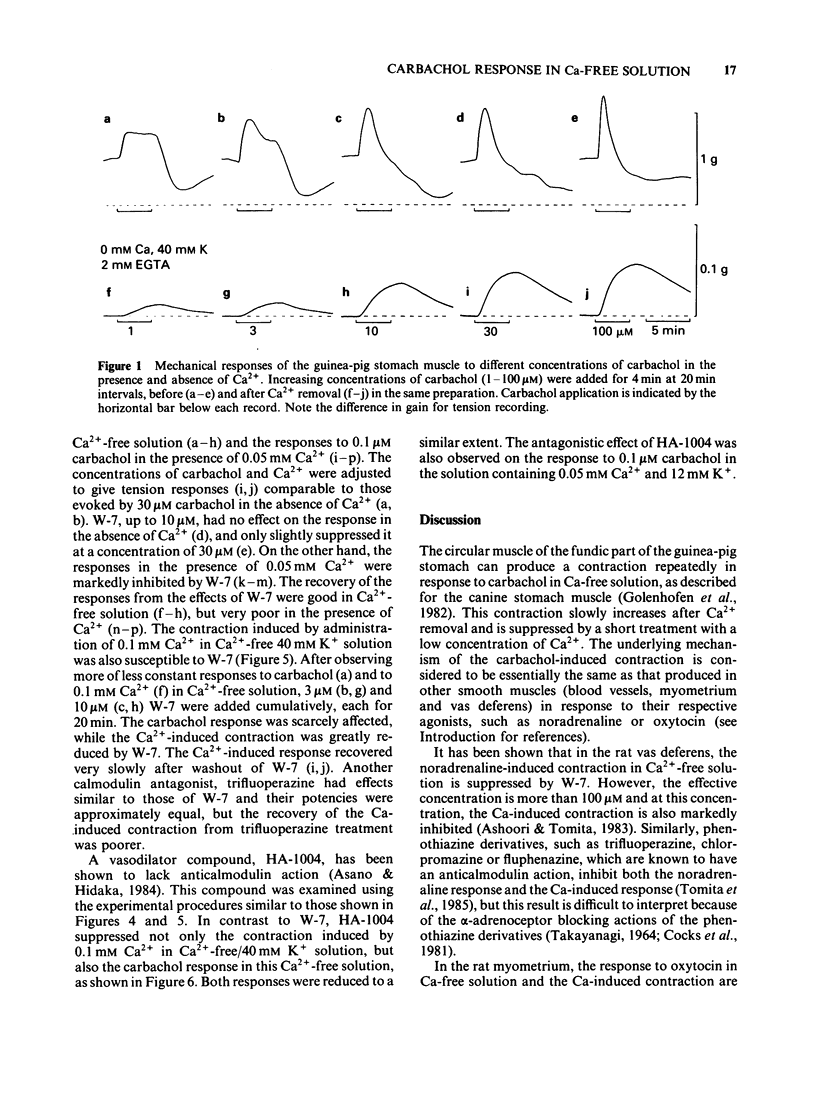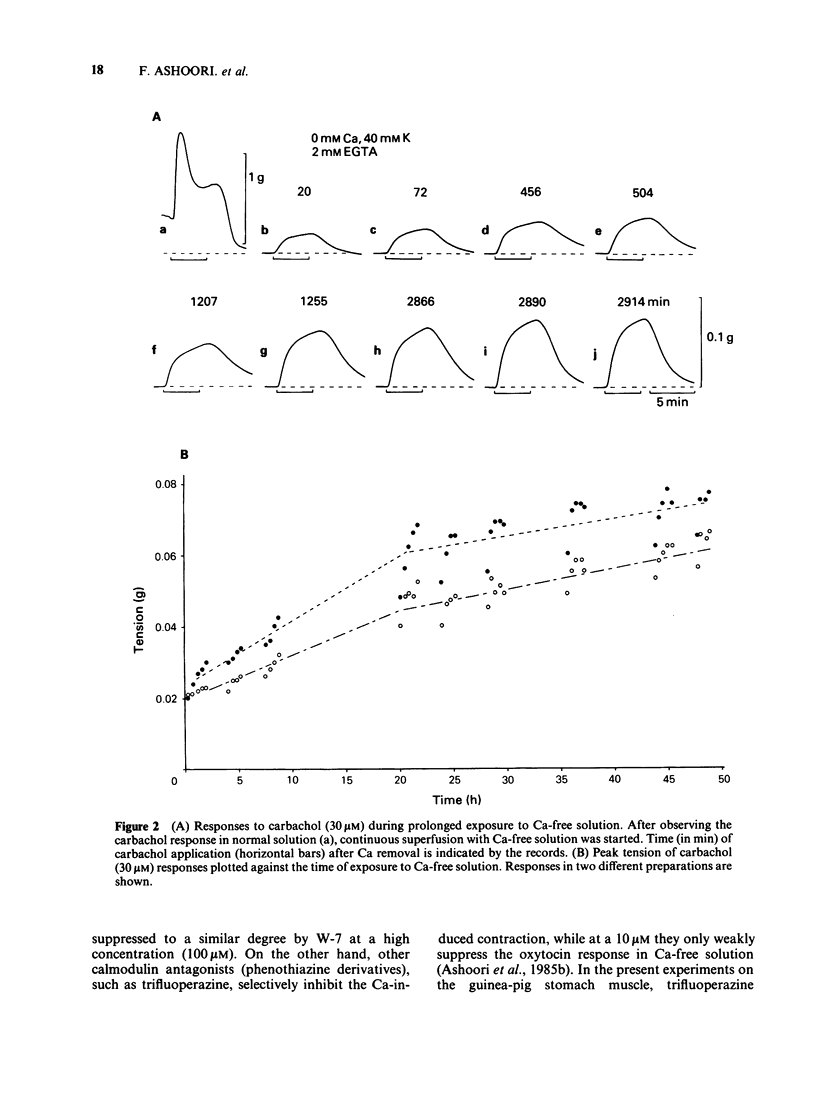Abstract
In the circular muscle of the fundic part of the guinea-pig stomach, a small tonic contraction could be repeatedly produced by carbachol in Ca-free solution containing 2 mM EGTA. The carbachol-induced response was gradually increased during prolonged exposure to Ca-free solution for 50 h, whereas a short treatment with 0.1-0.2 mM Ca suppressed the subsequent carbachol response in Ca-free solution. The response was not essentially modified by increasing the external K+ concentration to 40 mM. Calmodulin antagonists, N-(6-aminohexyl)-5-chloro-1-naphthalene sulphonamide (W-7) and trifluoperazine selectively suppressed the carbachol response in the presence of Ca (0.05 mM) and the contraction induced by Ca (0.1 mM), but they had little effect on the response to carbachol in Ca-free solution at a concentration of less than 10 microM. A vasodilator agent, N-(2-guanidinoethyl)-5-isoquinoline sulphonamide (HA-1004), inhibited the carbachol response both in the presence and absence of Ca, as well as the Ca-induced contraction, to a similar extent, provided that the external Ca concentration was less than 0.1 mM. These results led us to propose that the contraction evoked by carbachol in the absence of external Ca is mediated by a process independent of the Ca-calmodulin system.
Full text
PDF







Selected References
These references are in PubMed. This may not be the complete list of references from this article.
- Asano M., Suzuki Y., Hidaka H. Effects of various calmodulin antagonists on contraction of rabbit aortic strips. J Pharmacol Exp Ther. 1982 Jan;220(1):191–196. [PubMed] [Google Scholar]
- Asano T., Hidaka H. Vasodilatory action of HA1004 [N-(2-guanidinoethyl)-5-isoquinolinesulfonamide], a novel calcium antagonist with no effect on cardiac function. J Pharmacol Exp Ther. 1984 Oct;231(1):141–145. [PubMed] [Google Scholar]
- Ashoori F., Hidaka H., Takai A., Tomita T. Contraction of smooth muscle in Ca-free solution. Nihon Heikatsukin Gakkai Zasshi. 1985 Feb;21(1):57–69. doi: 10.1540/jsmr1965.21.57. [DOI] [PubMed] [Google Scholar]
- Ashoori F., Tomita T. Mechanical response to noradrenaline in calcium-free solution in the rat vas deferens. J Physiol. 1983 May;338:165–178. doi: 10.1113/jphysiol.1983.sp014667. [DOI] [PMC free article] [PubMed] [Google Scholar]
- Casteels R., Raeymaekers L., Suzuki H., Van Eldere J. Tension response and 45Ca release in vascular smooth muscle incubated in Ca-free solution. Pflugers Arch. 1981 Dec;392(2):139–145. doi: 10.1007/BF00581262. [DOI] [PubMed] [Google Scholar]
- Cocks T. M., Dilger P., Jenkinson D. H. The mechanism of the blockade by trifluoperazine of some actions of phenylephrine on liver and smooth muscle. Biochem Pharmacol. 1981 Oct;30(20):2873–2875. doi: 10.1016/0006-2952(81)90431-7. [DOI] [PubMed] [Google Scholar]
- Daniel E. E. Cellular calcium mobilization. J Cardiovasc Pharmacol. 1984;6 (Suppl 4):S622–S629. doi: 10.1097/00005344-198406004-00008. [DOI] [PubMed] [Google Scholar]
- Hartshorne D. J., Siemankowski R. F. Regulation of smooth muscle actomyosin. Annu Rev Physiol. 1981;43:519–530. doi: 10.1146/annurev.ph.43.030181.002511. [DOI] [PubMed] [Google Scholar]
- Heaslip R. J., Rahwan R. G. Evidence for the existence of two distinct pools of intracellular calcium in the rat aorta accessible to mobilization by norepinephrine. J Pharmacol Exp Ther. 1982 Apr;221(1):7–13. [PubMed] [Google Scholar]
- Hidaka H., Asano M., Iwadare S., Matsumoto I., Totsuka T., Aoki N. A novel vascular relaxing agent, N-(6--aminohexyl)-5-chloro-1-naphthalensulfonamide which affects vascular smooth muscle actomyosin. J Pharmacol Exp Ther. 1978 Oct;207(1):8–15. [PubMed] [Google Scholar]
- Hidaka H., Yamaki T., Naka M., Tanaka T., Hayashi H., Kobayashi R. Calcium-regulated modulator protein interacting agents inhibit smooth muscle calcium-stimulated protein kinase and ATPase. Mol Pharmacol. 1980 Jan;17(1):66–72. [PubMed] [Google Scholar]
- Mironneau C., Mironneau J., Savineau J. P. Maintained contractions of rat uterine smooth muscle incubated in a Ca2+-free solution. Br J Pharmacol. 1984 Jul;82(3):735–743. doi: 10.1111/j.1476-5381.1984.tb10813.x. [DOI] [PMC free article] [PubMed] [Google Scholar]
- Sakai K., Higuchi K., Yamaguchi T., Uchida M. Oxytocin-induced Ca-free contraction of rat uterine smooth muscle: effects of preincubation with EGTA and drugs. Gen Pharmacol. 1982;13(5):393–400. doi: 10.1016/0306-3623(82)90104-5. [DOI] [PubMed] [Google Scholar]
- Sakai K., Uchida M. A calcium reversal phenomenon: differentiation of excitatory and inhibitory roles of Ca in uterine smooth muscle contraction. Jpn J Pharmacol. 1980 Jun;30(3):394–396. doi: 10.1254/jjp.30.394. [DOI] [PubMed] [Google Scholar]
- Sakai K., Yamaguchi T., Uchida M. Oxytocin-induced Ca-free contraction of rat uterine smooth muscle: effects of divalent cations and drugs. Arch Int Pharmacodyn Ther. 1981 Mar;250(1):40–54. [PubMed] [Google Scholar]
- TAKAYANAGI I. PHENOTHIAZINE DERIVATIVES. RELATIONSHIP BETWEEN PERIPHERAL AND CENTRAL ACTIONS. Arzneimittelforschung. 1964 Jun;14:694–698. [PubMed] [Google Scholar]


